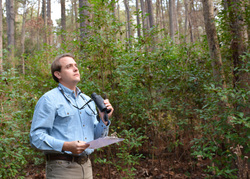SFA graduate student's research seeks to improve wildlife diversity in pine plantations
February 24, 2016
 Stephen F. Austin State University graduate student Joshua Harris pauses while conducting a survey to estimate the abundance, occupancy and richness of avian species in an East Texas pine plantation. Harris, pursing a Master of Science in forestry in the Arthur Temple College of Forestry and Agriculture, is investigating the differences of four different taxa in delineated timber stands of varied rotational phases. With this knowledge, Harris hopes to pinpoint which combination of forest edge types within pine plantations are most beneficial for wildlife.
Stephen F. Austin State University graduate student Joshua Harris pauses while conducting a survey to estimate the abundance, occupancy and richness of avian species in an East Texas pine plantation. Harris, pursing a Master of Science in forestry in the Arthur Temple College of Forestry and Agriculture, is investigating the differences of four different taxa in delineated timber stands of varied rotational phases. With this knowledge, Harris hopes to pinpoint which combination of forest edge types within pine plantations are most beneficial for wildlife.
Using other sampling techniques, Harris also is investigating the same parameters for small and large mammals, as well as invertebrates. He said the most exciting auditory detection during last summer's fieldwork was the call of a Bobwhite quail, a species whose numbers have steeply declined across the state as a result of habitat loss.
His research, funded by the Sustainable Forestry Initiative and taking place on timber management company-owned land, aims to better understand ecotones, or transitional areas between biologic communities, that can promote biodiversity. In the case of pine plantations, these ecotones are defined as the areas between delineated timber stands of varied rotational phases.
"Imagine a chessboard where every square is a separate stand within the whole board that represents a pine plantation," Harris said. "Because the stands are thinned and harvested at different times, the system is very dynamic with edges of high diversity changing size and location with every thinning or harvest cycle."
Harris said that although past research has identified practices that promote biodiversity within pine plantations, they often result in financial loss incurred by the landowner. His research, on the other hand, is focusing specifically on how current forest management practices can be most efficiently utilized to achieve the same goals of biodiversity and ecological health, while not resulting in fiscal losses.
By researching and understanding the conditions that best facilitate biodiversity in current timber management practices, landowners can be made aware of better stand rotation options that already exist, said Dr. Daniel Scognamillo, associate professor of wildlife ecology at SFA's Arthur Temple College of Forestry and Agriculture.
"Even if you keep managing your forest in the same way, if you have the chance to put these two (timber stand) ages together, it will benefit diversity," said Scognamillo, who also serves as Harris' advising professor on the project.
He adds that if landowners chose to implement the resulting timber management recommendations, they will form a conservation network enabling genetic diversity, health and distribution of wildlife species.
The timber stand edges Harris is analyzing are managed on an 18-year rotation, meaning that after 18 years of age, the stand can be clear-cut and replanted. The stages of the two other stand-edge types analyzed are defined as pre-thinning and post-thinning.
Harris said these three stand types can be combined to make three different types of edges within a managed forest: pre-thinned against post-thinned, pre-thinned against clear-cut, and clear-cut against post-thinned.
As Harris enters his second year of data collection, he said that preliminary analysis indicates there are differences in biodiversity among the different edge types. Following a statistical analysis, he will be able to pinpoint which combination of edge types most benefit all four taxa surveyed.
"It's another tool in the toolbox that will hopefully get landowners thinking more creatively about how they do things," Harris said.
Implementing the findings of Harris' research also will allow landowners seeking SFI Certification to fulfill three of the organization's 14 required principles of sustainable forest management. Additionally, due to similar ecosystems, Harris said his findings are applicable for growers of pine timber from East Texas to the East Coast.
"The motivation for this study comes form knowing that we have so much land as pine plantations, and all that land, we think, has the potential to be managed in such a way that will contribute to increased diversity in wildlife," said Scognamillo.
For more information regarding this or other research at the Arthur Temple College of Forestry and Agriculture, call 936-468-3301, or visit atcofa.sfasu.edu.